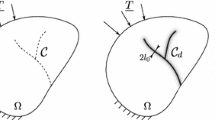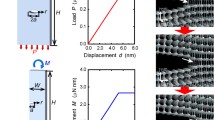Abstract
Linear elastic fracture mechanics provides a consistent framework to evaluate quantitatively the energy flux released to the tip of a growing crack. Still, the way in which the crack selects its velocity in response to this energy flux remains far from completely understood. To uncover the underlying mechanisms, we experimentally studied damage and dissipation processes that develop during the dynamic failure of polymethylmethacrylate, classically considered as the archetype of brittle amorphous materials. We evidenced a well-defined critical velocity along which failure switches from nominally-brittle to quasi-brittle, where crack propagation goes hand in hand with the nucleation and growth of microcracks. Via post-mortem analysis of the fracture surfaces, we were able to reconstruct the complete spatiotemporal microcracking dynamics with micrometer/nanosecond resolution. We demonstrated that the true local propagation speed of individual crack fronts is limited to a fairly low value, which can be much smaller than the apparent speed measured at the continuum-level scale. By coalescing with the main front, microcracks boost the macroscale velocity through an acceleration factor of geometrical origin. We discuss the key role of damage-related internal variables in the selection of macroscale fracture dynamics.





















Similar content being viewed by others
Notes
To measure this time shift, we directly connected the Wheatstone bridge of the load cell to an oscilloscope, without passing through the signal conditioner. This latter, indeed, imposes a time resolution of \(1\,\mathrm{s}\).
Fig. 3 Computation of SIF. Top typical mesh used for finite elements calculations, in order to access the stress/strain fields in the experiments. Red polymeric layer. Black sample. Blue L-shaped block. Green line cracked line. The slide link connected to the L-shaped block is used to model the motion of the contact point between the pushed wedge and the roller. Specimen loading is achieved by translating horizontally the slide link, from (0) to (1), over a distance \(u_{wedge}\) selected so that the horizontal force applying on the slide link is half that measured experimentally. Bottom-Left zoom on the meshing in the transition region (red) between coarse meshing (\(1~\,\mathrm{mm}\) mesh size) in the bulk and fine meshing close to the crack tip. On the right is shown part of the circular hole at the seed crack tip. Bottom-Right zoom on the crack-tip region (green), meshed with a size of \(1\,\mathrm{nm}\)
References
Adda-Bedia M, Arias R, Ben-Amar M, Lund F (1999) Dynamic instability of brittle fracture. Phys Rev Lett 82:2314
Ahrens TJ, Rubin AM (1993) Impact-induced tensional failure in rocks. J Geophys Res Planets 98:1185
Anthony SR, Chub JP, Congleton J (1970) The crack branching velocity. Philos Mag 22:1201
Bergkvist H (1974) Some experiments on crack motion and arrest in polymethylmethacrylate. Eng Fract Mech 6:621
Bonamy D (2009) Intermittency and roughening in the failure of brittle heterogeneous materials. J Phys D Appl Phys 42:214014
Bonamy D, Prades S, Rountree CL, Ponson L, Dalmas D, Bouchaud E, Ravi-Chandar K, Guillot C (2006) Nanoscale damage during fracture in silica glass. Int J Fract 140:3
Bouchbinder E, Mathiesen J, Procaccia I (2005) Branching instabilities in rapid fracture: dynamics and geometry. Phys Rev E 71:056118
Bouchbinder E, Livne A, Fineberg J (2008) Weakly nonlinear theory of dynamic fracture. Phys Rev Lett 101:264302
Bouchbinder E, Marder M, Fineberg J (2010) The physics of simple cracks. Annu Rev Condens Matter Phys 1:371
Boudet JF, Ciliberto S, Steinberg V (1995) Experimental study of the instability of crack propagation in brittle materials. Europhys Lett 30:337
Boudet JF, Ciliberto S, Steinberg V (1996) Dynamics of crack propagation in brittle materials. J Phys II Fr 6:1493
Bruhwiler E, Wittmann FH (1990) The wedge splitting test: a method for performing stable fracture mechanics tests. Eng Fract Mech 35:117
Buehler MJ, Abraham FF, Gao HJ (2003) Hyperelasticity governs dynamic fracture at a critical length scale. Nature 426:141
Cast3M finite element code: http://www-Cast3M.cea.fr/
Celarié F, Prades S, Bonamy D, Dickelé A, Bouchaud E, Guillot C, Marlière C (2003) Surface fracture of glassy materials as detected by real-time atomic force microscopy (afm) experiments. Appl Surf Sci 212:92–96
Célarié F, Prades S, Bonamy D, Ferrero L, Bouchaud E, Guillot C, Marlière C (2003) Glass breaks like metal but at the nanometer scale. Phys Rev Lett 90:075504
Cotterell B (1968) Fracture propagation in organic glasses. Int J Fract 4:209
Deschanel S, Vanel L, Godin N, Maire E, Vigier G, Ciliberto S (2009) Mechanical response and fracture dynamics of polymeric foams. J Phys D Appl Phys 42:214001
Du P, Xue B, Song Y, Zuo M, Lu S, Zheng Q, Yu J (2010) Experimental observation and computer simulation of conic markings on fracture surfaces of polymers. J Mater Sci 45:3088
Estevez R, Tijssens MGA, der Giessen EV (2000) Modeling of the competition between shear yielding and crazing brittle polymers. J Mech Phys Solids 48:2585
Ferretti D, Rossi M, Royer-Carfagni G (2011) An espi experimental study on the phenomenon of fracture in glass. Is it brittle or plastic? J Mech Phys Solids 59:1338–1354
Fineberg J, Gross SP, Marder M, Swinney HL (1992) Instability in the propagation of fast cracks. Phys Rev B 45:5146
Fond C, Schirrer R (2001) Dynamic fracture surface energy values and branching instabilities during rapid crack propagation in rubber toughened pmma. C R Acad Sci Paris 329:195
Freund LB (1990) Dynamic fracture mechanics. Cambridge University Press, Cambridge
Goldman T, Livne A, Fineberg J (2010) Acquisition of inertia by a moving crack. Phys Rev Lett 104:114301
Guerra C, Scheibert J, Bonamy D, Dalmas D (2012) Understanding fast macroscale fracture from microscale post-mortem patterns. Proc Natl Acad Sci USA 109:390
Gumbsch P, Zhou SJ, Holian BL (1997) Molecular dynamics investigation of dynamic crack stability. Phys Rev B 55:3445
Henry H (2008) Study of the branching instability using a phase field model of inplane crack propagation. EPL 83:16004
Henry H, Levine H (2004) Dynamic instabilities of fracture under biaxial strain using a phase field model. Phys Rev Lett 93:105504
Holloway DG (1968) The fracture of glass. Phys Educ 3:317
Hull D (1999) Fractography: observing, measuring and interpreting fracture surface topography. Cambridge University Press, Cambridge
Irwin GR, Kies JA (1952) Fracturing and fracture dynamics. Weld J Res Suppl 31:95
Kalthoff JF, Winkler S, Beinert J (1976) Dynamical stress inetnsity factors for arresting cracks in dbc specimens. Int J Fract 12:317
Karihaloo BL, Xiao QZ (2001) Higher order terms of the crack tip asymptotic field for a wedge-splitting specimen. Int J Fract 112:129
Kies JA, Sullivan AM, Irwin GR (1950) Interpretation of fracture markings. J Appl Phys 21:716
Kobchenko M, Panahi H, Renard F, Dysthe KD, Malthe-Sørenssen A, Mazzini A, Scheibert J, Jamtveit B, Meakin P (2011) 4D imaging of fracturing in organic-rich shales during heating. J Geophys Res 116:B12201
Livne A, Bouchbinder E, Svetlizky I, Fineberg J (2010) The near-tip fields of fast cracks. Science 327:1359
Moore DE, Lockner DA (1995) The role of microcracking in shear-fracture propagation in granite. J Struct Geol 17:95
Murali P, Guo T, Zhang Y, Narasimhan R, Li Y, Gao H (2011) Atomic scale fluctuations govern brittle fracture and cavitation behavior in metallic glasses. Phys Rev Lett 107:215501
Panahi H, Kobchenko M, Renard F et al (2012) A 4D Synchrotron X-ray-tomography study of the formation of hydrocarbon-migration pathways in heated organic-rich shale. SPE J. SPE-162939-PA (in press; posted 27 November 2012)
Persson BNJ, Brener EA (2005) Crack propagation in viscoelastic solids. Phys Rev E 71:036123
Prades S, Bonamy D, Dalmas D, Bouchaud E, Guillot C (2005) Nano-ductile crack propagation in glasses understress corrosion: spatiotemporal evolution of damage in the vicinity of the crack tip. Int J Solids Struct 42:637
Rabinovitch A, Bahat D (2008) Mirror-mist transition in brittle fracture. Phys Rev E 78:067102
Rabinovitch A, Belizovsky G, Bahat D (2000) Origin of mist and hackle patterns in brittle fracture. Phys Rev B 61:14968
Ravi-Chandar K (1998) Dynamic fracture of nominally brittle materials. Int J Fract 90:83
Ravi-Chandar K (2004) Dynamic fracture. Elsevier Ltd, Amsterdam
Ravi-Chandar K, Knauss WG (1984) An experimental investigation into dynamic fracture-ii microstructural aspects. Int J Fract 25:65
Ravi-Chandar K, Yang B (1997) On the role of microcracks in the dynamic fracture of brittle materials. J Phys Mech Solids 45:535
Regel VR (1951) O mekhanizme kheupkogo razusheniya plastmass. Zhurnal Tekhnicheskoi Fiziki 21:287
Rice JR (1968) A path independent integral and the approximate analysis of strain concentration by notches and cracks. J Appl Mech 35:379
Rosakis AJ, Duffy J, Freund LB (1984) The determination of dynamic fracture toughness of aisi 4340 steel by the shadow spot method. J Mech Phys Solids 32:443
Rountree CL, Kalia RK, Lidorikis E, Nakano A, Brutzel LV, Vashishta P (2002) Atomistic aspects of crack propagation in brittle materials: multimillion atom molecular dynamics simulations. Annu Rev Mater Res 32:377
Rountree CL, Bonamy D, Dalmas D, Prades S, Kalia RK, Guillot C, Bouchaud E (2010) Fracture in glass via molecular dynamics simulations and atomic force microscopy experiments. Phys Chem Glass Eur J Glass Sci Technol B 51:127
Scheibert J, Guerra C, Célarié F, Dalmas D, Bonamy D (2010) Brittle/quasi-brittle transition in the dynamic fracture of nominally brittle materials: an energetic signature. Phys Rev Lett 104:045501
Sharon E, Fineberg J (1999) Confirming the continuum theory of dynamic brittle fracture for fast cracks. Nature 397:333
Smekal (1953) Zum bruchvorgang bei sprodem stoffverhalten unter ein-and mehrachsigen beanspruchungen. Osterr Ing Arch 7:49
Spatschek R, Hartmann M, Brener E, Muller-Krumbhaar H, Kassner K (2006) Phase field modeling of fast crack propagation. Phys Rev Lett 96:015502
Washabaugh PD, Knauss W (1994) A reconciliation of dynamic crack velocity and rayleigh wave speed in isotropic brittle solids. Int J Fract 65:97
Acknowledgments
We warmly thank K. Ravi-Chandar (Univ. of Texas, Austin) for many illuminating discussions. We also thank T. Bernard (SPCSI) for technical support, P. Viel and M. Laurent (SPCSI) for gold deposits, and A. Prevost (ENS, Paris) for his help with the profilometry measurements at ENS. We also acknowledge funding from French ANR through Grant No. ANR-05-JCJC-0088 and from Triangle de la Physique through Grant No. 2007-46.
Author information
Authors and Affiliations
Corresponding author
Rights and permissions
About this article
Cite this article
Dalmas, D., Guerra, C., Scheibert, J. et al. Damage mechanisms in the dynamic fracture of nominally brittle polymers. Int J Fract 184, 93–111 (2013). https://doi.org/10.1007/s10704-013-9839-y
Received:
Accepted:
Published:
Issue Date:
DOI: https://doi.org/10.1007/s10704-013-9839-y





